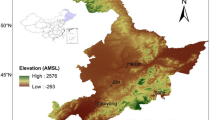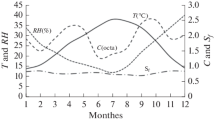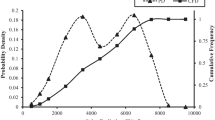Abstract
This study aims to recognize that whether introducing various meteorological parameters to the Angström–Prescott (A–P) model eventuates in enhancing the precision of monthly mean global solar radiation estimation in cities of Bandar Abbas and Jask, situated in the south coast of Iran. To identify the significance of the average, maximum and minimum ambient temperatures, average and maximum relative humidity as well as water vapor and sea level pressures, seven models have been chosen from the literature. Using the long-term measured data and via statistical regression technique, the new regression coefficients have been developed for the original A–P model and the other seven nominated models. The models’ performances have been appraised via commonly utilized statistical indicators. The results indicated that the new models provided only minor improvements over the traditional A–P model; therefore, as more complexity is associated with introducing different meteorological parameters, their applications are not appealing practically. Making comparisons with the existing models developed using PSO (particle swarm optimization) technique demonstrated the superiority of the new established A–P models of this study; consequently, even without any improvement, the simple A–P models are indeed qualified for accurate estimation of global solar radiation in cities of Bandar Abbas and Jask and their neighboring.





Similar content being viewed by others
Change history
19 December 2018
The Editors-in-Chief of Environmental Earth Sciences are issuing an editorial expression of concern to alert readers that this article (Mohammadi et al. 2016) shows substantial indication of irregularities in authorship during the submission process. The authors suggested peer reviewers whose identity was not possible to verify. This article contains overlap with Khorasanizadeh et al. (2013, 2014), Mohammadi et al. (2014), Shamshirband et al. (2016) (amongst others). All authors disagree with this editorial expression of concern.
Abbreviations
- a–f:
-
Regression coefficients
- APE:
-
Absolute percentage error (%)
- Gsc :
-
Solar constant (equal to 1367 W/m2)
- \( \bar{H} \) :
-
Monthly mean daily global radiation on horizontal surface (MJ/m2)
- \( \bar{H}_{o} \) :
-
Monthly mean daily extraterrestrial on horizontal surface (MJ/m2)
- \( \bar{H}_{i,c} ,\bar{H}_{i,m} \) :
-
ith calculated and measured values of \( \bar{H} \) (MJ/m2)
- \( \bar{K}_{T} \) :
-
Monthly mean daily clearness index
- MABE:
-
Mean absolute bias error (MJ/m2)
- MAPE:
-
Mean absolute percentage error (%)
- \( \bar{n} \) :
-
Monthly mean daily sunshine hours (hr)
- nday :
-
Number of days
- \( \bar{N} \) :
-
Monthly mean daily maximum possible sunshine hours (hr)
- \( \bar{P} \) :
-
Monthly mean daily sea level pressure (mb)
- \( \bar{P}_{V} \) :
-
Monthly mean daily water vapor pressure (mb)
- RMSE:
-
Root mean square error (MJ/m2)
- R:
-
Correlation coefficient
- \( \bar{R}_{h} \) :
-
Monthly mean daily relative humidity (%)
- \( \bar{R}_{h\hbox{max} } \) :
-
Monthly mean daily maximum relative humidity (%)
- \( \bar{T}_{avg} \) :
-
Monthly mean daily ambient temperature (ºC)
- \( \bar{T}_{\hbox{max} } \) :
-
Monthly mean daily maximum ambient temperature (ºC)
- \( \bar{T}_{\hbox{min} } \) :
-
Monthly mean daily minimum ambient temperature (ºC)
- δ:
-
Solar declination angle (deg.)
- φ:
-
Latitude of the location (deg.)
- ωs :
-
Sunset hour angle (deg.)
References
Abdalla YAG (1994) New correlation of global solar radiation with meteorological parameters for Bahrain. Int J Sol Energy 16:111–120
Akinoglu BG, Ecevit A (1990) A further comparison and discussion of sunshine based models to estimate global solar radiation. Sol Energy 15:865–872
Almorox J, Hontoria C (2004) Global solar radiation estimation using sunshine duration in Spain. Energy Convers Manage 45:1529–1535
Angström A (1924) Solar and terrestrial radiation. Quart J Roy Met Soc 1924(50):121–125
Bahel V, Bakhsh H, Srinivasan R (1987) A correlation for estimation of global solar radiation. Energy 12:131–135
Bakirci K (2009) Correlations for estimation of daily global solar radiation with hours of bright sunshine in Turkey. Energy 34:485–501
Behrang MA, Assareh E, Noghrehabadi AR, Ghanbarzadeh A (2011) New sunshine based models for predicting global solar radiation using PSO (particle swarm optimization) technique. Energy 36:3036–3049
Benmouiza K, Cheknane A (2013) Forecasting hourly global solar radiation using hybrid k-means and nonlinear autoregressive neural network models. Energy Convers Manage 75:561–569
Boland J, Huang J, Ridley B (2013) Decomposing global solar radiation into its direct and diffuse components. Renew Sustain Energy Rev 28:749–756
Casares FJ, Lopez-Luque R, Posadillo R, Varo-Martinez M (2014) Mathematical approach to the characterization of daily energy balance in autonomous photovoltaic solar systems. Energy 72:393–404
Coskun C, Oktay Z, Dincer I (2011) Estimation of monthly solar radiation distribution for solar energy system analysis. Energy 36:1319–1323
Demirhan H (2014) The problem of multicollinearity in horizontal solar radiation estimation models and a new model for Turkey. Energy Convers Manage 84:334–345
Diagne M, David M, Lauret P, Boland J, Schmutz N (2013) Review of solar irradiance forecasting methods and a proposition for small-scale insular grids. Renew Sustain Energy Rev 27:65–76
Duffie JA, Beckman WA (2006) Solar engineering of thermal processes, 3rd edn. Wiley, New York
Elagib AA, Mansell MG (2000) New approaches for estimating global solar radiation across Sudan. Energy Convers Manage 41:419–434
El-Sebaii AA, Al-Ghamdi AA, Al-Hazmi FS, Faidah AS (2009) Estimation of global solar radiation on horizontal surfaces in Jeddah, Saudi Arabia. Energy Policy 37:3645–3649
Gani A, Mohammadi K, Shamshirband S, Khorasanizadeh H, Danesh AS, Piri J, Ismail Z, Zamani M (2015) Day of the year-based prediction of horizontal global solar radiation by a neural network auto-regressive model. Theor Appl Climatol. doi:10.1007/s00704-015-1533-8
Garg HP, Garg ST (1982) Prediction of global solar radiation from bright sunshine hours and other meteorological parameters. In: Solar-India, Proceedings of the national solar energy convention. Allied Publishers, New Delhi, 1004–1007
Glover J, McCullogh JSG (1958) The empirical relation between solar radiation and the hours of bright sunshine. Quart J Roy Met Soc 84:172–175
Halouani N, Nguyen CT, Vo-Ngoc D (1993) Calculation of monthly average global solar radiation on horizontal surfaces using daily hours of bright sunshine. Sol Energy 50:247–248
Jiang Y (2009) Estimation of monthly mean daily diffuse radiation in China. Appl Energy 2009(86):1458–1464
Jin Z, Yezheng W, Gang Y (2005) General formula for estimation of monthly average daily global solar radiation in China. Energy Convers Manage 46:257–268
Khorasaninejad E, Hajabdollahi H (2014) Thermo-economic and environmental optimization of solar assisted heat pump by using multi-objective particle swam algorithm. Energy 72:680–690
Kottek M, Grieser J, Beck C, Rudolf B, Rubel F (2006) World map of the Köppen-Geiger climate classification updated. Meteorol Z 15(3):259–263
Newland FJ (1988) A study of solar radiation models for the coastal region of South China. Sol Energy 31:227–235
Ododo JC, Sulaiman AT, Aidan J, Yguda MM, Ogbu FA (1995) The importance of maximum air temperature in the parameterization of solar radiation in Nigeria. Renew Energy 6:751–763
Ogelman H, Ecevit A, Tasdemiroglu E (1984) A new method for estimating solar radiation from bright sunshine data. Sol Energy 33:619–625
Ojosu JO, Komolafe LK (1987) Models for estimating solar radiation availability in South Western Nigeria. Nig J Solar Energy 6:69–77
Prescott JA (1940) Evaporation from a water surface in relation to solar radiation. Trans R Soc Sci Austr 64:114–125
Tasdemiroglu E, Sever R (1991) An improved correlation for estimating solar radiation from bright sunshine data for Turkey. Energy Convers Manage 31(6):599–600
Trabea AA, Shaltout MAM (2000) Correlation of global solar radiation with meteorological parameters over Egypt. Renew Energy 21:297–308
Ulgen K, Hepbasli A (2002) Comparison of solar radiation correlations for Izmir, Turkey. Int J Energy Res 26:413–430
Yacef R, Mellit A, Belaid S, Şen Z (2014) New combined models for estimating daily global solar radiation from measured air temperature in semi-arid climates: application in Ghardaia, Algeria. Energy Convers Manage 79:606–615
Acknowledgments
The authors would like to thank the University of Malaya for the research grants allocated (UMRG-RP015C-13AET and High Impact Research Grant, HIR-D000015-16001).
Author information
Authors and Affiliations
Corresponding author
Rights and permissions
About this article
Cite this article
Mohammadi, K., Khorasanizadeh, H., Shamshirband, S. et al. Influence of introducing various meteorological parameters to the Angström–Prescott model for estimation of global solar radiation. Environ Earth Sci 75, 219 (2016). https://doi.org/10.1007/s12665-015-4871-z
Received:
Accepted:
Published:
DOI: https://doi.org/10.1007/s12665-015-4871-z




